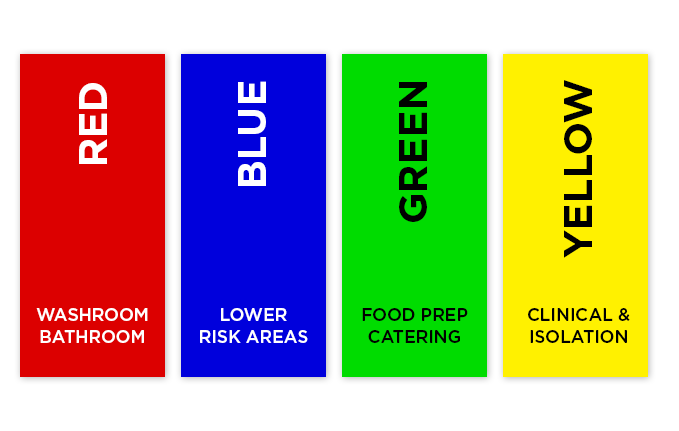Colour Standards: What Are The Benefits Of Colour Coding?
The use of colour-coded products for cleaning healthcare facilities has been around for years. However, although the concept of colour coding cleaning products has been widely used in many healthcare environments, such as care homes for instance, there still isn’t a universal code. However, many hospitals, care homes, and other healthcare facilities have called for one, to make cleaning safer and to lower the risk of infection being spread.
Is there a universal standard?
In the UK, the British Institute of Cleaning Science developed a “universal” code for cleaning in the late 1990’s. The code it developed supported the National Patient Safety Agency (NPSA’s) National Colour Coding System, that relied on four core colours - red, blue, green, and yellow. It was suggested that red should be used for products or materials used for bathrooms, washrooms, showers, toilets, basins and bathroom floors. It was recommended that blue was used for general areas including wards, departments, offices and basins in public areas, and that green was used for catering departments, ward kitchen areas and patient food service at ward level. While yellow was suggested to be used for isolation areas. The NPSA recommended that all NHS facilities adopt this code as a standard code of practice. It has since been recommended that all healthcare facilities, from doctor’s surgeries to nursing homes, do the same.

However, NPSA states that although the majority of hospitals and care homes already have a colour code in place for their cleaning products, equipment and materials, it’s been estimated that there are about 50 different schemes in place, with various facilities using different colour codes. Most colour coding does revolve around the same core colours, however, each hospital or care home seems to use them differently to the next. Even some facilities within the same trust or group use different colour standards, posing a risk when staff work in various facilities within the same group.
The reason that colour standards are so important in the first place is because by colour coding products, materials, and equipment used in different areas of a facility, the risk of cross-infection becomes much lower. This is because when cleaning products are used in multiple areas, the risk of bacteria being spread from place to place is much higher.
What items should you colour code?
- Single-Use Aprons
- Disposable Gloves
- Mops
- Buckets
- Brushes
- Brooms
The concept of colour coding is to make everyone working in the healthcare industry aware of what each colour relates to. This helps to prevent mistakes being made with cleaning, ending in dangerous cross contamination. However, without a standard colour code in place, when healthcare workers move from one facility to another, it can lead to confusion and cross-contamination when cleaning.
This is why calls for a colour code that is completely universal to the UK have been made. If cleaning products are used in one area, such as the bathroom, and are then used in another, like in a general area, they can spread E Coli and Norovirus. Although there is currently no universal code in place, it is recommended that all healthcare facilities follow the British Institute of Cleaning Science’s colour coding advice.





